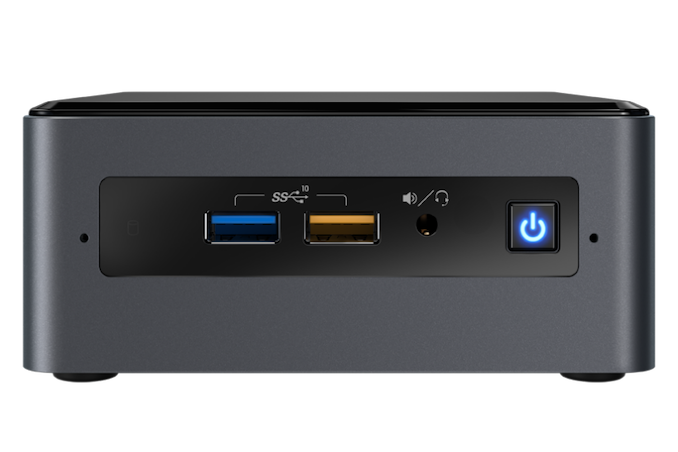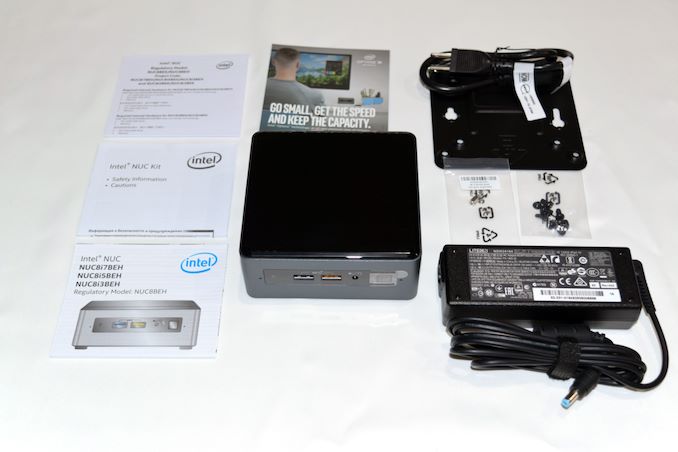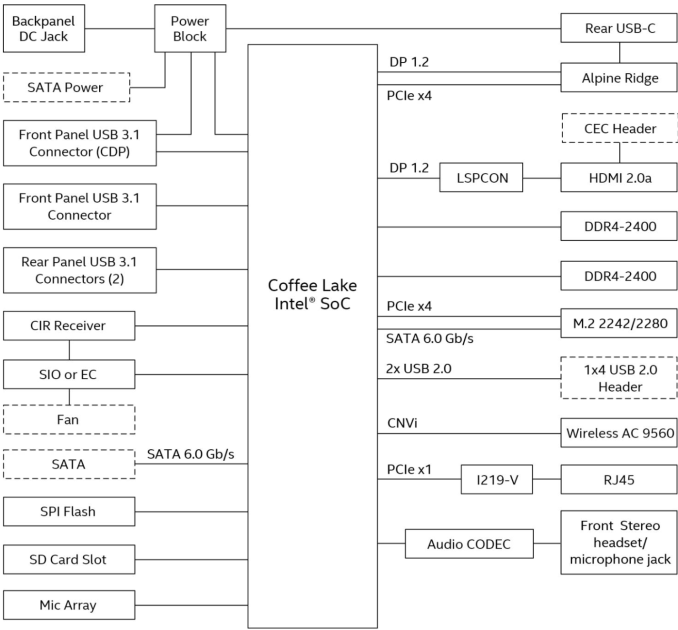Intel's Bean Canyon (NUC8i7BEH) Coffee Lake NUC Review - Ticking the Right Boxes
by Ganesh T S on April 3, 2019 8:00 AM EST- Posted in
- Systems
- Intel
- NUC
- UCFF
- Thunderbolt 3
- Cannon Point
- Coffee Lake-U

Intel's NUCs have managed to develop a strong market for ultra-compact form-factor (UCFF) machines since they were introduced in the early 2010s. Each CPU generation has seen Intel put out stronger versions of the NUC (both in terms of performance and features) in a regular cadence. In parallel, we have seen experiments with slightly larger form-factors (such as the Skull Canyon and Hades Canyon NUCs). Currently, Intel has NUC platforms targeting three different market segments - the entry-level, mid-range, and enthusiast. While the entry level is served by Atom-class SoCs and the enthusiast category by H-/G-series CPUs, the mid-range is served by the U-series SiPs (system in package) that use the Core microarchitecture. Today, we are looking at Intel's latest flagship in the mid-range segment - the Core i7-based Bean Canyon (NUC8i7BEH).
Introduction and Platform Analysis
The Intel NUC8i7BEH belongs to the Bean Canyon NUC family. It is based on the Coffee Lake-U series SiPs (CFL-U). The Bean Canyon NUCs build upon the capabilities of the Kaby Lake NUCs (NUC7 / Baby Canyon series). From an external I/O perspective, the Bean Canyon and Baby Canyon NUCs do not appear significantly different. However, the usage of a CFL-U SiP (CPU and PCH integrated in a single package) enables the following updates in the Bean Canyon family:
- 28W TDP processors across all SKUs, with true quad-core / octa-thread options
- Iris Plus Graphics 655 with 128MB eDRAM across all SKUs
- Intel Wireless-AC 9560 with Bluetooth 5.0 WLAN module
- USB 3.1 Gen 2 (10 Gbps) support on all external Type-A ports
The TDP upgrade (15W to 28W) makes it necessary for Intel to supply a 90W power adapter with the Bean Canyon NUCs (compared to the 65W ones supplied with the Baby Canyon models).
The NUC8i7BEH that we are looking at today comes with a Core i7-8559U processor. The 'H' in the model indicates a tall kit with support for the installation of a 2.5" SATA drive. The kit is available barebones, and users need to install either a SATA or a M.2 2280 / 2260 / 2242 NVMe drive and appropriate DDR4 SO-DIMMs. We utilized a Western Digital Black NVMe SSD and two G.Skill DDR4-3000 SODIMMs to complete our build.
The specifications of our Intel NUC8i7BEH (Bean Canyon) review configuration are summarized in the table below.
| Intel NUC8i7BEH (Bean Canyon) Specifications | |
| Processor | Intel Core i7-8559U Coffee Lake-U, 4C/8T, 2.7 (4.5) GHz 8MB L2, 28 W TDP |
| Memory | G.Skill RipjawsV F4-3000C16-16GRS DDR4 SODIMM 18-18-18-43 @ 3000 MHz 2x16 GB |
| Graphics | Intel Iris Plus Graphics 655 |
| Disk Drive(s) | Western Digital WD Black 3D NVMe SSD (2018) (1 TB; M.2 Type 2280 PCIe 3.0 x4 NVMe; SanDisk 64L 3D TLC) |
| Networking | Intel Dual Band Wireless-AC 9560 (2x2 802.11ac - 1733 Mbps) Intel I219V Gigabit Ethernet controller |
| Audio | 3.5mm Headphone Jack Capable of 5.1/7.1 digital output with HD audio bitstreaming (HDMI) |
| Miscellaneous I/O Ports | 1x Thunderbolt 3 Type-C 4x USB 3.1 Gen 2 Type-A 1x micro-SDXC |
| Operating System | Retail unit is barebones, but we installed Windows 10 Enterprise x64 |
| Pricing | $503 (barebones) $963 (as configured, no OS) |
| Full Specifications | Intel NUC8i7BEH Specifications |
The Intel NUC8i7BEH (Bean Canyon) kit comes with a quick-start guide, hardware for VESA mounting, bunch of screws for installing the storage drives, and a 90 W (19V @ 4.74A) adapter with a US power cord.
The gallery below takes us around the hardware in the unit.
Platform Analysis
The Core i7-8559U package integrates an Intel Cannon Point-LP platform controller hub (PCH). Intel's documentation describes the board layout in detail.
The distribution of the PCIe lanes from the SiP is brought out to a large extent in the above block diagram. The system report summary generated by AIDA64 provides additional insights:
- PCI-E 3.0 x1 port #1 In Use @ x1 (Intel I219-V Gigabit Ethernet)
- PCI-E 3.0 x4 port #5 In Use @ x4 (Intel JHL6340 Alpine Ridge Thunderbolt 3 Controller)
- PCI-E 3.0 x4 port #9 In Use @ x4 (Western Digital Black 3D NVMe SSD)
- PCI-E 3.0 x1 port #15 In Use @ x1 (Realtek RTS522A PCI-E Card Reader)
The integrated PCH enables four USB 3.1 Gen 2 ports that are present as Type-A ports in the front and rear of the chassis. CFL-U also supports CNVi, the new 'integrated connectivity' feature that puts the Wi-Fi and Bluetooth MAC inside the PCH. In the NUC8i7BEH, the CRF (companion RF) module completes the Wireless-AC 9560 by implementing the signal processing, RF, and analog functions. The Intel Wireless-AC 9560 is a significant upgrade over the Wireless-AC 8265 in the Kaby Lake NUCs. It comes with Wave 2 features, including support for 160 MHz channels and downlink MU-MIMO. The 2x2 WLAN module is theoretically capable of 1.73 Gbps bandwidth. It also integrates dual-mode Bluetooth 5 support.
Intel continues to use a LSPCon on board to convert the Display Port 1.2 output of the processor to a HDMI 2.0 port with HDCP 2.2. Unfortunately, stereoscopic 3D is not supported in this configuration. However, the Thunderbolt 3 USB Type-C port's display output is compliant with HDCP 2.2 also.
In the table below, we have an overview of the various systems that we are comparing the Intel NUC8i7BEH (Bean Canyon) against. Note that they may not belong to the same market segment. The relevant configuration details of the machines are provided so that readers have an understanding of why some benchmark numbers are skewed for or against the Intel NUC8i7BEH (Bean Canyon) when we come to those sections.
| Comparative PC Configurations | ||
| Aspect | Intel NUC8i7BEH (Bean Canyon) | |
| CPU | Intel Core i7-8559U | Intel Core i7-8559U |
| GPU | Intel Iris Plus Graphics 655 | Intel Iris Plus Graphics 655 |
| RAM | G.Skill RipjawsV F4-3000C16-16GRS DDR4 SODIMM 18-18-18-43 @ 3000 MHz 2x16 GB |
G.Skill RipjawsV F4-3000C16-16GRS DDR4 SODIMM 18-18-18-43 @ 3000 MHz 2x16 GB |
| Storage | Western Digital WD Black 3D NVMe SSD (2018) (1 TB; M.2 Type 2280 PCIe 3.0 x4 NVMe; SanDisk 64L 3D TLC) |
Western Digital WD Black 3D NVMe SSD (2018) (1 TB; M.2 Type 2280 PCIe 3.0 x4 NVMe; SanDisk 64L 3D TLC) |
| Wi-Fi | Intel Dual Band Wireless-AC 9560 (2x2 802.11ac - 1733 Mbps) |
Intel Dual Band Wireless-AC 9560 (2x2 802.11ac - 1733 Mbps) |
| Price (in USD, when built) | $503 (barebones) $963 (as configured) |
$503 (barebones) $963 (as configured) |


















81 Comments
View All Comments
cacnoff - Wednesday, April 3, 2019 - link
These are platform PCIe lanes that come off the OPI (on package interface) as there are no discrete pch options for U series cpus.Check the direct processor page here.
https://www.intel.com/content/www/us/en/products/p...
"PCI Express (PCIe) Configurations describe the available PCIe lane configurations that can be used to link the PCH PCIe lanes to PCIe devices."
DenvR - Wednesday, April 3, 2019 - link
I'm pretty sure all 14nm U-series processors feature at least 8 PCIe 3.0 lanes, some even more (the i5-7200U has got 12 of those and the i7-8559U 16. Please correct me if I'm wrong.vortexmak - Wednesday, April 3, 2019 - link
Did Intel drop the IR receiver from the NUC?mikato - Thursday, April 4, 2019 - link
I wondered this also. The board layout diagram has a "CIR Receiver" so maybe that's it. But I'm really surprised there is no mention in the system specs table next to I/O or in any of the HTPC pages of the article. Wasn't it one of the good selling points of these Intel boxes?CSMR - Wednesday, April 3, 2019 - link
Shame that this is lacking a full displayport output, instead making it an old DP1.2 share a thunderbolt output. Displayport is more important than hdmi for a machine that is overkill for HTPC use. i7s will be much more often connected to monitors than to TVs.mischlep - Wednesday, April 3, 2019 - link
For the Intel NUC8i7BEH (Bean Canyon), in the Comparative PC Configurations, does the listed price "$963 (as configured)" include an OS or not? The other selections (other than the NUC7i7BNH) explicitly said "as configured, No OS". You specifically marked it as "as configured, no OS" in the specifications on the first page.PeachNCream - Wednesday, April 3, 2019 - link
The price is a bit high, but I'm guessing some of that is due to the Iris GPU which is a thing I'd love to see appear in a wider variety of systems. Iris is a good idea from a power consumption and cooling simplification standpoint when compared to most dGPU offerings on the lower end of the scale.QChronoD - Wednesday, April 3, 2019 - link
Still only HDMI 2.0 and DP1.2 on these? I guess I can only hope that next version will have finally been updated to support 4k120 w/ VRR.abufrejoval - Wednesday, April 3, 2019 - link
This CPU IMHO is one of the best designs Intel has and I’ve been itching to buy one of these for quite some time, albeit always in a slightly different form factor.For starters just enter i7-8559U into your Google search bar and hit “shopping”. You’ll notice, there are exactly two offerings: The NUC for around €500 and the MacBooks between €2000 and €3500. Perhaps the latter costs extra, because it includes one Terabyte of SSD, €120 these days in a market with competition. It certainly has just the same CPU/GPU as the €2000 model.
I own the Skylake predecessor, also designed for Apple, an i5-6267U but in a cheap Windows notebook, which has an Iris 550 iGPU with close to identical graphics performance, but only half the number of cores that top out at 3.3 GHz, but doesn’t drop below 2.9 GHz even if abused by Prime95.
It’s a sweet machine, giving nicely balanced CPU and graphics power and most importantly, it had zero price premium at the time, for twice the graphics punch of ordinary 520 or 530 iGPUs. It also performs very much identical to a 512 graphics core Kaveri A10-7850K in *every regard*, CPU INT and FP, GPU, OpenCL, only that the Kaveri uses 95 Watts not 28. It was quite simply the better APU and stopped me buying AMDs since.
It also has such great Linux compatibility CentOS, Fedora, Ubuntu and Android-x86, none of the grief Nvidia and AMD give you: I know how to manage that with all those V100, GTX and RTX I operate, but I also appreciate not having to.
Alas, you cannot buy this newer CPU inside a notebook other than at crazy Apple prices. And incidentally, you cannot buy it as a Mini-ITX either: You’re stuck with NUC or nothing… which is sort of ok, now that you stuff terabytes of NVMe at affordable prices inside.
This chip must be quite a bit more expensive to make, twice the GPU silicon real-estate, eDRAM, packaging etc., but Intel doesn’t charge extra for GPU, no matter what type, just for peak clock speed.
But it seems they also simply won’t sell the chip, not for the official price or any other, unless you’re Apple or buy a NUC. I still don’t know how Medion managed to grab sufficient number of them to produce a €600 laptop, but I knew enough to grab one, enjoyed it ever since and I am writing on it just now.
So if I cannot have another as a notebook, I’d love to use it as a mini-server: That’s another use case where the fantastic power efficiency at low loads or idle, combined with its pretty awesome sprint power is well appreciated. But I’d really like it to have ECC memory then and a slightly bigger fan for quiet operation even under load, because it will run “forever” and use consistency critical stuff, including ZFS for Linux.
But because that makes it the nicer Xeon-D for many, Intel will cut that fuse…
For Intel this NUC must be one of the lowest profit items in their inventory, which translates to one of the best value propositions if you can live with the limitations. In theory you should be able to buy the board without the case and there is at least one company out there that sells fan-less cases to fit the guts of this NUC.
Even if that case costs a €200 premium, you can still buy two fully loaded passive NUCs with 32GB of RAM and 4TB of SSD before you reach Apple entry territory.
gglaw - Wednesday, April 3, 2019 - link
"With Thunderbolt 3 having matured, and the availability of various eGFX enclosures, the absence of a discrete GPU in the NUC8i7BEH will hardly be felt."completely disagree. Relying on huge, bulky, and costly external implementations is a horrible idea compared to paying a small premium and getting better GPU inside the NUC. Who in the world would buy a mini PC knowing they're going to frequently need to plug it into a huge box multiple times the size of the NUC and driving the total cost to a whole new bracket? There's a reason why the eGFX market is a tiny, niche market.
These are not priced as budget PC solutions, so the small price bump to get better graphics inside the box is completely worth it for users who want that type of performance. Or for others who will use it strictly for media and productivity the can stick with Intel Graphics. Almost no one should buy the base Intel Graphics with the idea of adding an eGFX solution later. They'd be better off selling the base one and buying a Ryzen or Vega M-Intel solution.